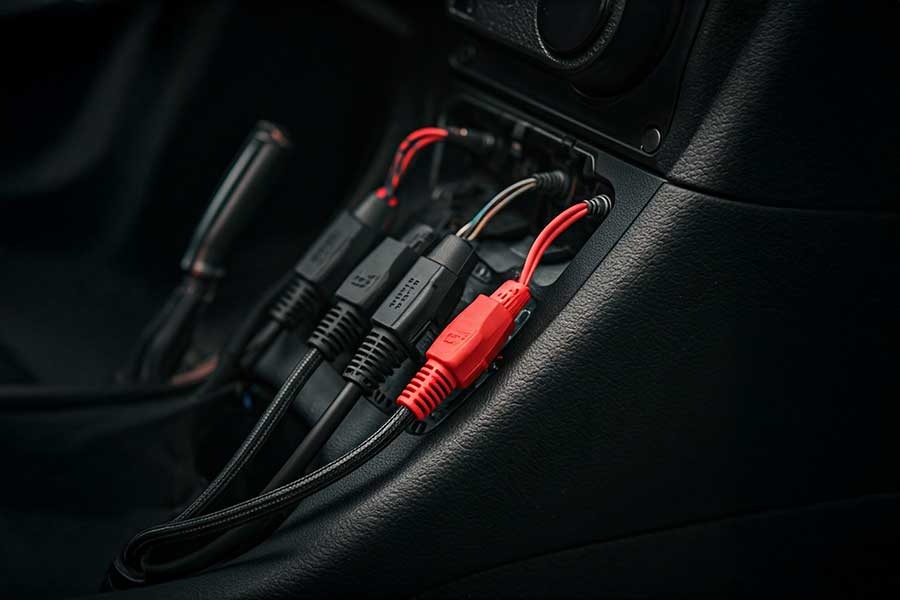
Listening to your favorite music in your car is a great way to make your journeys more enjoyable. However, the excellent audio experience is not limited to just quality speakers and a tape recorder. Choosing the right cables and connecting them correctly is just as important. In this text, we will take a closer look at what cables used in in-car audio systems are, their types, characteristics, and what to consider when choosing them.
The Importance of Cables in In-Car Audio Systems
Cables are vital ports that transmit audio signals and power between the different components of your audio system. Poor quality or improperly connected cables can lead to loss of sound quality, interference, or even system failures. Therefore, choosing the right cables and connecting them correctly is critical to achieving the best audio experience. Ülkü cable offers you the most suitable cabling solutions to get the best performance from your sound system in your vehicle.
Cable Types in In-Car Audio Systems
The main types of cables used in in-car audio systems are:
- Power Cables: These cables, which provide power transmission from the battery to the amp, are usually red (positive) and black (negative/chassis) colors. As their thickness (AWG value) increases, they can carry higher current. It's important to choose a cable that is the right thickness for your amp's power requirement.
- Speaker Cables: These cables, which transmit audio signals from the amp to the speakers, can usually be double-wire and of different colors (e.g., white/white stripes, green/green stripes). It is important to choose a cable that matches the impedance and power of the speakers.
- RCA Cables (Signal Cables): These cables, which transmit low-level audio signals from the source unit (tape) to the amp, are usually red (right channel) and white (left channel) in color. Quality RCA cables minimize interference and provide a cleaner sound transmission.
- Remote Control Cable: This cable, which is used to turn on the amp when the tape is turned on, is usually blue in color.
- Antenna Cable: It is the coaxial cable that transmits radio signals to the receiver.
Things to Consider When Choosing a Cable
Choosing the right cables is important for sound quality and system performance. Here are some factors to look out for:
- Cable Thickness (AWG): Current carrying capacity is important for power cables. For higher power amps, thicker wires (lower AWG rating) should be preferred. For speaker cables, the thickness suitable for the power of the speaker should be selected.
- Cable Quality: A good cable minimizes signal loss and provides a cleaner audio transmission. You should choose well-shielded cables made of quality materials. Shielding is especially important in RCA cables.
- Cable Length: Cables that are longer than necessary can cause signal loss. Take care to choose a cable of the length you need. However, very short cables can also cause difficulty in assembly.
- Connectors: Quality connectors ensure reliable connection and minimize signal loss.
- Oxygen-Free Copper (OFC) Cables: OFC cables can be preferred because they have better conductivity.
Cable Assembly and Connections
Correctly mounting and connecting cables is just as important as cable selection. Here are some tips:
- Route Cables Properly: Route cables so that they do not touch the vehicle's metal parts and, if possible, together with the original wiring harnesses. This helps to avoid interference.
- Secure the Cables: Secure them using cable ties or clips so that the cables are not affected by vibration and are not damaged.
- Make the Correct Connections: Connect the wires by paying attention to the correct polarity. Incorrect connections can damage the system.
- Use a Fuse: Install a suitable fuse in the power cord from the battery to the amp, close to the battery. This protects the system in the event of a short circuit.
Sample Cable Selection
- Low Power System (100-200W): 8 AWG power cable, 16 AWG speaker wire may suffice.
- Medium Power System (200-500W): 4 AWG power cable, 14 AWG speaker cable can be preferred.
- High Power System (500W+): 0 or 2 AWG power cord, 12 AWG or thicker speaker wire recommended.
Result
In in-car audio systems, cables are critical components that are often overlooked but significantly affect sound quality. By choosing the right cables, installing and connecting them correctly, you can get the best audio experience in your vehicle. Remember, speakers and tape recorders alone are not enough for a quality sound system; The right cables are also an important part of this equation. Ülkü Kablo will help you with the right cable selection and application suggestions.
